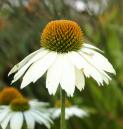Ligustrum. L. vulgare L. Troene, Fr. Rain-weide, Hartriegel, G. Privet or Prim.—A shrub of the Fam. Oleaceae, from four to ten feet in height, growing wild both in Europe and the United States, usually in hedges and by the roadside. The leaves, which have an astringent, bitter taste, and the flowers, which are small, snow-white, and of an agreeable odor, have been used in the form of decoction in sore throat and aphthous and scorbutic ulceration of the mouth. The berries are black, have a sweetish bitter taste, and are said to possess purgative properties, and to color the urine brown. They are sometimes used for dyeing. Death in a child between two and three years old is recorded by James Cheese (P. J., 2d ser., viii, 607), as due to the eating of privet berries. The bark was analyzed by M. G. Polex, who found a peculiar substance, which he denominated ligustrin, insoluble in ether and absolute alcohol, but soluble in water and diluted alcohol. Strong sulphuric acid gives with ligustrin a deep indigo-blue color. Kromayer (A. Pharm. (2), cxviii, 19) proved that Polex's ligustrin was only impure syringin, C19H28O10 + H2O. The large white crystals become anhydrous at 115° C. (239° F.), and fuse at 212° C. (413.6° F.). He found in addition (see Kromayer, A. Pharm., (2) ci, 281) mannite, sugar, muco-saccharine matter, starch, chlorophyll, bitter extractive, bitter resin, tannin, albumen, and salts. (A. J. P., xii, 347.) Kromayer found besides the syringin a crystallized bitter principle, fusing at a little over 100° C. (212° F.), which he named ligustron.
Botanical name:

